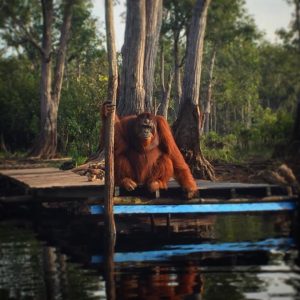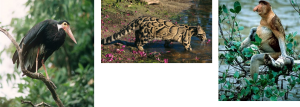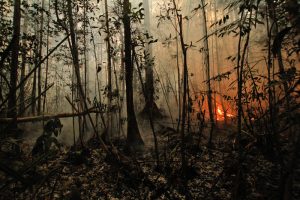
Sitting on the end of a creaky old jetty with its peeling blue paint sits Kuntuk, a magnificent, flanged male orangutan. His eyes staring hard at you with a look that could only have one meaning: stay away! His gaze is steady as his hand clutches the pole next to him, his hunched frame guarding the entrance to the rainforest behind him, with the light illuminating his vibrant orange coat.
If only this was enough to protect the pristine forests, peatlands and all their inhabitants behind him from the companies and corporations hacking them down to make way for plantations of rubber and palm oil.
The destruction of natural habitats in Kalimantan (the Indonesian part of Borneo) doesn’t only impact the orangutans that swing through its trees however, it effects everything around.
There is large scale biodiversity loss through the illegal logging of threatened tree species iron-wood and ramin; and, removes the homes for rare species like clouded leopards, bearded pigs, macaques, slow loris and tarsiers.

The rainforests of Kalimantan are also home to the richest swamp habitats in the tropics and 34% of all flora and fauna are unique to the island (Djoko Susilo 1997).
These peatland swamps provide vital homes for many species, including proboscis monkeys, the rare Storm’s stork and a vast number of endemic fish species. They are, however, unsuitable for growing most crops and many are therefore cleared and drained for agricultural use through slash and burn practices. The dry peat is highly flammable and difficult to extinguish once burning, this leads to fires spreading out of control (Goldammer & Seibert 1990).
The burning of the peat also releases massive amounts of stored Carbon into the atmosphere; 75% of Indonesia’s CO2 emissions are due to change in land cover from forests to plantations or barren land (Carlson et al. 2013). This is adding to the problem of global warming through greenhouse gases (Someshwar et al. 2010).

Extensive land clearing in the past caused wildfires during the 1980’s that destroyed 5 million hectares of rainforest in Kalimantan and killed thousands of plants and animals (Goldammer & Seibert 1990). Since then, between 1990 and 2010, palm oil plantations have expanded to 538,346km2, 90% of which were previously forested.
Forest cover directly influences rainfall so its removal leads to less rain and drier land, allowing for more forest fires (Leighton, 2002). The fires remove nutrients from the soil making it difficult for plants to recolonise the area (Page et al. 2000). Without the vegetation cover or waterlogged ground, the vertebrate and invertebrate species cannot return, producing barren land useful only for more plantations.
Without the rainforests and peatlands, there is no home for the orangutans and other unique forms of life, meaning they will simply fade out of existence and this photo of Kuntuk will just serve as a haunting reminder of yet another species wiped out by human activity.
References
Campbell-Black, A., 2016. Kuntuk, the male flanged orangutan. [Photo]
Capilla, B.R. & OuTrop, 2015. Sabangau Forest burning. Bali Spirit Festival. [Photo]
Carlson, K.M. et al., 2013. Carbon emissions from forest conversion by Kalimantan oil palm plantations. Nature Clim. Change, 3(3), pp.283–287.
Djoko Susilo, H., 1997. The Tanjung Puting National Park and Biosphere Reserve, United Nations Educational, Scientific and Cultural Organisation.
Fink, K.W., n.d. Storm’s Stork. ARKive. Ardea Images.
Fletcher & Baylis, 2002. Proboscis Monkey. ARKive. Wildside Photography.
Goldammer, J.G. & Seibert, B., 1990. The Impact of Droughts and Forest Fires on Tropical Lowland Rain Forest of East Kalimantan. Fire in the Tropical Biota: Ecosystem Processes and Global Challenges, pp. 11–31.
Leighton, D. M., 2002. Illegal Logging Effects on Indonesian Biodiversity. ABC NEWS.
Page, S.E. et al., 2000. Impact of the 1997 fires on the peatlands of Central Kalimantan, Indonesia. 11th International Peat Congress, pp.962–970.
Someshwar, S., Boer, R. & Conrad, E., 2010. Managing Peatland Fire Risk in Central Kalimantan, Indonesia, Washington DC.
Stone, L.M., 2004, Clouded Leopard. ARKive. Nature Picture Library.
Word count: [490]
Recent Comments